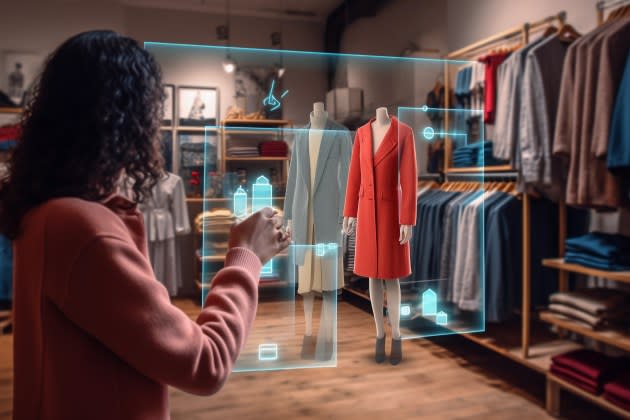Generative AI: The Key to Reinventing Retail and Optimizing Growth, Say Industry Experts

Citing the firm’s global chief executive officer survey, analysts at PwC said their poll confirms “that executives are turning to generative AI as a critical tool to reinvent their businesses. That innovation, which took the world by storm in 2023, shows no signs of slowing down.”
Indeed. Generative AI was all the talk at the NRF show last month, and it is expected to be the talk de jour at the upcoming Shoptalk event. But why all the buzz?
More from WWD
Pharrell Williams' Black Ambition Prize Aims to Empower Entrepreneurs
Gucci Designer Sabato De Sarno on Miley Cyrus' Bag, Commercial Pressures and Runway Showmanship
Brand Assembly Offers Intimate, Energetic Trade Show for Contemporary, Wellness and Beauty
According to the PwC report, generative AI “can provide the engine for nearly every growth lever that CEOs want to pull, from optimizing costs to creating new revenue streams to improving the customer experience.” Of those polled, 61 percent of CEOs expect the technology to improve the quality of their services and products.
To help retail and brand executives make better-informed decisions before investing in generative AI, WWD presents the second installment of a series of stories on AI, generative AI and predictive AI, and related technologies.
AI investments: wait and see?
Tom Taulli, author of “Generative AI: How ChatGPT and Other AI Tools Will Revolutionize Business,” told WWD that the temptation “is to take a wait-and-see approach to generative AI. But this would be a big mistake. Just look at how this strategy backfired during the early days of e-commerce.”
“Besides, customers want better experiences,” Taulli said, adding that a recent IBM study showed that 59 percent of consumers said they want AI applications for shopping. “They also are interested in relevant/personalized offers and advertisements.”
Taulli said this is where generative AI can make a big difference. However, there needs to be a strategy behind implementation. “A key advantage for retailers is that they generate huge amounts of data,” the author said. “However, there still needs to be a well-thought-out data strategy. If not, the generative AI will not get the best results. There can be [AI] hallucinations and inaccuracies.”
Taulli also said there will be a need “to ground the models with the data. This is not easy. This requires sophisticated expertise from data scientists. But, of course, this talent is expensive. Yet there are emerging many good off-the-shelf solutions, such as from Microsoft and Google.”
Another key consideration is where to implement the technology. Taulli said retailers should focus “on those areas where generative AI will move the needle. These include virtual assistants, which can track orders, place orders and find the nearest store; intelligent order management (for handling return requests); personalized offers and recommendations, customer insight, such as with sentiment analysis.”
Lastly, Taulli said data security and privacy policies should be strengthened.
Legal and security considerations
Eugene Klimaszewski, founder of Mammoth Security Inc., said data privacy and security are paramount. “Retail executives must ensure that the massive volumes of data that generative AI systems require are handled correctly. Adhering to privacy legislation and putting in place strong data protection procedures are essential for safeguarding consumer information as well as for preserving credibility and trust.”
Gai Sher, attorney at Greenspoon Marder, said as AI tends to rely on existing or user-generated data to train and strengthen its algorithms, “a retailer must ensure that neither the inputs nor the generated outputs infringe on any third-party rights, specifically intellectual property, and privacy rights. This requires a company to diligently survey its data sources, the nature of its algorithms, and its outputs to remain compliant.”
Compliance is essential, but from a legal perspective, retailers and brands need to do more. Sher said since AI is supported by the volume of its data and the frequency of user inputs, “retailers should consider their collection, storage, handling and processing protocols in the context of their own data and consumer privacy policies, including established privacy regulations like the GDPR in Europe and the CCPA in California.” Sher said companies should also “establish clear and transparent disclaimers regarding their use of AI in their services and products, including its compliance with consumer protection laws.”

“Finally, if you’re not prepared to develop AI technology in-house but are outsourcing your AI mechanisms from third-party vendors, it’s crucial to ensure your commercial agreements are robust and clear on liabilities, IP rights, security, data usage and protection, confidentiality and compliance with applicable laws and regulations,” Sher said.
Kirk Sigmon, attorney at Banner & Witcoff Ltd., who specializes in AI and is an IBM-certified machine-learning professional, said it is also important to step back and consider how generative AI will not only be used but understand how the AI was trained.
“It is unfortunately very common for AI models to be trained on copyright-infringing training sets, which means that users of those AI models might expose themselves to lawsuits down the road,” Sigmon told WWD. “Unfortunately, it’s very difficult to tell when an AI model has been trained in a questionable manner: even if you try to train your own models in-house, the pressure for accuracy (and the ever-present need for large volumes of data) can introduce lawsuit risks. The best strategy nowadays appears to be a strong contract: make sure someone else is legally responsible for the training as well as if something goes wrong — for example, if a model is trained using copyright-infringing material, if it outputs biased content, or the like.”
Ray Lauzums, president and CEO of Poggers, a gaming company, said there are other issues to consider, such as customization for a retailer’s business. Lauzums said it’s “a bit like tailoring a suit — one size doesn’t fit all. Retailers should look for AI solutions that can be adjusted to match their unique way of doing things. This customization ensures that the technology actually works for their specific type of retail and their diverse customer base.”
And what about ROI?
Lauzums said long-term benefits and risks need to be considered as well. “Picture it like a financial investment — you want to know if it’s worth it,” Lauzums said. “Retail leaders should carefully weigh the costs and benefits of implementing generative AI. It’s not just about the initial spending but also considering ongoing maintenance costs. And, like any investment, it’s smart to be aware of potential risks and have a plan to manage them.”
Kamil Bajołek, brand director at prm.com, which is a new project under answear.com, agreed with Lauzums about longer-term benefits and ROI and said it is key to have a brand discussion, too.
“Retail leaders looking at generative AI should keep in mind that AI needs to match with the brand,” Bajołek said. “Any technological investment, including AI, should resonate with what the brand stands for. If a brand is known for its personalized customer service, then AI should be used to make it better, more personalized, not replace and change the entire service.”
Bajołek said there’s also the ROI issue. “Retail leaders need to have a clear vision of how AI will drive business growth or improve operational efficiency,” Bajołek said. “Without this, it simply doesn’t make sense. This could be through customer insights, streamlined supply chain management or more effective marketing strategies. But you need a clear goal. It’s also important to consider the scalability of AI solutions. AI systems should be adaptable and scalable to meet changing business needs and customer demands. This flexibility remains relevant in the long term.”
Closing thoughts
Harshul Asnani, president of technology and media business for the Americas at Tech Mahindra, said retail and brand leaders eyeing Generative AI “as the next frontier in their digital evolution should navigate this terrain with strategic foresight.”
Asnani said the World Economic Forum’s projections “are not just numbers; they herald a transformative era, with Gen AI’s potential resonating across the bustling aisles of global commerce.” Asnani said the current investment in AI within the retail sector is pegged at $5 billion and is estimated to reach $31 billion by 2028.
“This leap signifies more than a trend; it is a seismic shift, redefining customer interactions, supply chain logistics and market analytics,” Asnani told WWD. “However, the glimmer of AI’s promise does not eclipse the need for detailed consideration. Retail leaders should weigh the ethical implications, ensuring that AI’s generative capabilities are harnessed without compromising consumer trust or privacy.”
Asnani said integrating generative AI “should not be a mere technological upgrade but a strategic endeavor, aligning with the brand’s ethos and customer expectations.” Asnani said generative AI “is an excellent driver for conversational commerce as it can solve the major issue of search abandonment in the retail industry that reports a global loss of over $2 trillion annually.”
Another consideration of AI implementation is regulatory. “The fluid landscape of international regulations on AI also calls for a proactive stance,” Asnani said. “Staying ahead of legislative curves ensures compliance and secures a competitive edge. Investment in AI should also entail investment in human capital. Cultivating a workforce adept at merging human creativity with AI’s analytical prowess will be pivotal. In the tapestry of global retail, where patterns of consumption are as diverse as the palette of cultures, understanding regional nuances will be crucial.”
Asnani said generative AI offers the tools for tailored experiences, predicting trends and streamlining operations, “but it’s the human touch in its deployment that will weave these threads into sustained growth and innovation. As retail leaders stand at this crossroads, the path they choose must be as informed and discerning as the technologies they seek to employ.”
Best of WWD


